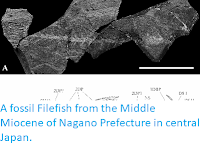Sunfish, Mola spp., are the largest extant Boney Fish, reaching up to 2.3 tonnes in mass, 3.0 m in height, and 4.3 m in height. They are striking animals, with a disc-shaped body resembling a giant head, no dorsal fin, and a tail lobes set at right angles to the body which extend some way above and below the rest of the Fish. Sunfish are planktivores, feeding primarily on Jellyfish, but also consuming significant amounts of other zoo- and phyto-plankton; they will also feed on inappropriate items such as plastic bags if these are available, and have been known to die from plastic consumption. The behaviour of Sunfish is as remarkable as their appearance; they are curious, and will often approach divers, appear to be poor swimmers, but are capable of breaching the water surface, with leaps as high as 3 m recorded. The Sunfish are members of the Tetraodontiformes, a highly specialised group of Perciforme Fish that also includes, Pufferfish, Boxfish, Filefish and Filefish. There are currently three recognised species of Sunfish, the Ocean Sunfish, Mola mola, the Southern Sunfish, Mola alexandrini, and the Hoodwinker Sunfish, Mola tecta, which was only named in 2017. Species of Sunfish can be difficult to tell apart, with recent reforms of their taxonomy based upon genetic data having led to the dropping of several species names formerly accepted as valid.
A Southern Sunfish, Mola alexandrini, near the island of Gozo in the Mediterranean in February 2018. Marianne Nyegaard/Erik van der Goot/FishBase/Wikimedia Commons.
The larvae of Sunfish are poorly known, and even harder to identify than the adults, so when the Australian Research Vessel Investigator collected several specimens during a plankton trawl off the coast of New South Wales in 2017, they were forwarded to Marianne Nyegaard, a Research Fellow at the Auckland War Memorial Museum, and an expert on Sunfish, who has been heavily involved in the recent genetics-based revision of the group's taxonomy, including being the senior author of the study which identified the Hoodwinker Sunfish, Mola tecta, and contributed to another recent study which re-described the Southern Sunfish, Mola alexandrini, based upon genetic and morphological data.
Larval Sunfish caught off the coast of New South Wales in 2018 during a plankton trawl by the RV Investigator.
Nyegaard forwarded the specimens to Andrew King of the Australian Museum Research Institute, who was able to extract DNA from one of the specimens, which had been preserved in alcohol, and compare it to a database of genetic samples that had been built up during the revision of the group's taxonomy. This produced a clear match, firmly identifying the larvae as members of the species Mola alexandrini, the Southern Sunfish, the larvae of which had not previously been identified.
2 mm long larvae of the Southern Sunfish, Mola alexandrini, collected from off the coast of New South Wales in 2017. Kerryn Parkinson/Australian Museum.
See also...
Follow Sciency Thoughts on Facebook.





